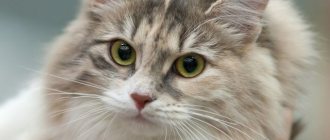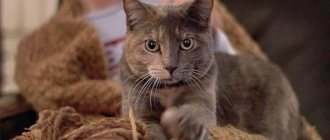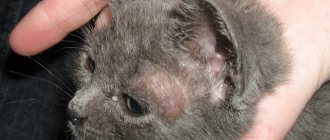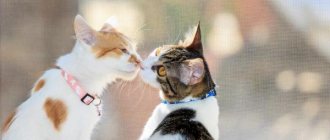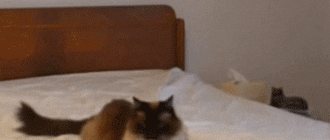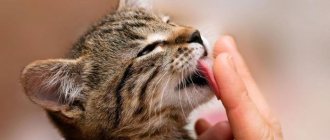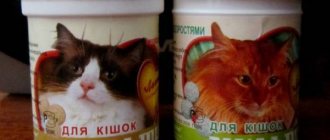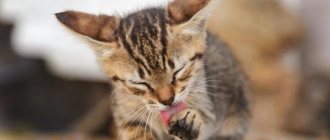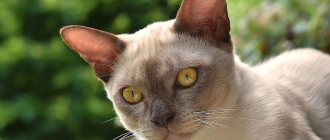Domestic cats, representatives of wild animals, were revered in Ancient Egypt. They were worshiped, idolized and even sacrificed to them. But with the advent of the Middle Ages, attitudes towards cats changed dramatically. They began to be considered the mediator of evil spirits in our world.
Dogs are considered to be the first animals that humans began to domesticate. Since ancient times, these animals were in close proximity to humans and their homes, helping to hunt and guard the house, protect themselves from predators and ill-wishers. As for cats, everything is much more complicated. Until now, scientists have not solved the mystery of the appearance of domestic cats, and why people decided to make them a popular pet.
Turkish Angora
According to one version, the ancestor of the breed was a wild forest Pallas cat, who lived in the Middle Ages on the territory of the Ottoman Empire. According to another version, it is believed that the breed originated from the Libyan steppe cat, inhabiting the territories of Africa and the Middle East. The exact origin is quite difficult to establish, because the angora appeared several thousand years ago. What is known for certain is that the cats were bred in the Turkish city of Angora, where the name of the breed came from.
The Turkish Angora has always been held in high esteem by aristocrats and rulers. Long-haired white cats attracted attention with their charm and extraordinary grace. In ancient times, representatives of the breed with different eye colors were especially valued. It was believed that such pets bring wealth and prosperity to the home.
Big cats
So, big cats. What is known about them? Firstly, they are of respectable size and have identical features. First of all, these are external signs. In addition, they lead the same lifestyle and use almost the same methods to get their food.
Surprisingly, but true: representatives of the feline family, such as tigers and lions, can mate with each other, and the existing genetic differences do not leave their mark on the offspring.
However, despite similar characteristics, there are significant differences between them. This is not surprising if we take into account the living conditions of these animals. Lions are a more family-oriented species, having a single leader and a small number of females with many cubs, which are looked after by all the females, regardless of who their mother is, as well as teenage lions. As soon as the young animals grow up, the leader kicks adult males out of the flock, protecting himself from potential competitors. Another surprisingly cruel fact from the life of lions is that if a new leader appears in a pride (for example, if the previous one becomes weaker or grows old and can no longer provide worthy resistance to young males), the first thing he does is get rid of all the cubs in the pack.
The tiger lives alone, looking for a mate only during the mating season. When hunting, the tiger also acts as a hermit. As a rule, he forages for food alone. Having caught the prey, the tiger will slowly eat it, and none of the animals will dare to join this meal.
The lion acts differently . He will not hunt in splendid isolation. The main hunters of prey in lion prides are females. Lions, as a rule, go out hunting in groups, chasing one animal, which then becomes common prey. Lions can also go without food for a long time, despite their amazing appetite (an adult lion can eat an amount of food equal to a third of its body weight at one time). A well-fed lion can sleep up to 20 hours and not go hunting for a week.
of a pack of cats is interesting . In this community, the leading role is played by females, around whom the rest of the animals unite. This is evidenced by the already mentioned fact of the distribution of roles in the pride. Moreover, if the existence of male representatives in a flock is very unstable (they can be driven away by stronger relatives), then the composition of female cats, as a rule, does not change.
Other felines also have their own characteristics. For example, a leopard does not growl. This is due to the specific structure of this cat’s vocal cords. The jaguar has many interesting features. Its most important difference is its coloring. In terms of nutrition, this predator can be considered a gourmet, since it prefers to feast on turtles. The peculiarity of the motor system allows large species of cats to move at considerable speed.
Persian cat
Persian cats are such an ancient species that it is no longer possible to determine their exact origin. Its roots go back to ancient Persia, now the territory of Iran. It was from there that in 1622 the traveler Pietro della Valle brought several Persian cats to Italy. The breed received its official recognition in the 19th century in England. This country is considered the second homeland of the Persians. It was here that painstaking selection work began to improve the breed and develop new varieties.
From Europe, the Persian cat came to America, where work continued to improve and diversify its external qualities. It was in the USA that the exotic shorthaired variety of Persians was first bred.
Persian long-haired beauties appeared in Russia only at the end of the 20th century. Amazingly beautiful animals with an unusual nose shape were brought to us by diplomats from Europe in the 80s.
The Persian appearance is distinguished by a snub nose and large, expressive eyes. Initially, only blue color was recognized among Persians. At the moment, the breed has about a hundred varieties differing in coat length, color and body structure.
Sphinx food
Character: intelligent, inquisitive and demanding. Syjami are very talkative and do not like to be ignored.
Pros: Elegant, smart, intelligent. They get along well with children and easily get used to collars and leashes.
- Cons: very demanding and active work. They don't like to be alone, they don't like to sit in a cage, they are very talkative. They need warmth.
- History: The conquest of Europe by Thai cats began at the end of the 19th century. At that time, about ten Siamese cats were brought to England, and some differences in body construction can be seen. Consequently, 2 types of cats were distinguished: one with a strong structure and a rounded head (the ancestors of the modern Thai), and the other with more shaped animals with an elongated head (the ancestors of the modern Siams). Currently, Thai cats come in three types: classic, traditional and modern. Along with changing the name of the race, more attention was paid to its purity.
Diet for a kitten
Appearance: The WCF standard requires the Thai cat to have a round head and a prominent chest. It is quite massive, but this massiveness should not be feared. Its oriental origin highlights my almond-shaped eyes and slightly spaced ears. As a result of numerous crossword puzzles, the integration of Thai cats has become quite diverse, and now cream, red, tabby and tortoise have been added to the original Blu-, Power-, lilac dot and chocolate flowers.
Character: Thai cats have an equal, balanced temperament. This Cat breed can be a great companion for one person or a child for a child. All the myths about Vengyphum of Thai are just myths that have nothing to do with reality. The Thai cat is characterized by high intelligence. Breeders of this breed, answering the question “Why does a Thai cat have a big forehead?” - they joke: “Because for such an ideal brain you need a lot of space!”
Pros: Excellent health.
Cons: The Thai cat population has been impacted by accidental breeding over the years, causing traditional Thais to evaporate the metars. This has led to the current difficulties in Genas Pula.
History: Apparently, the first Russian blue cats were brought to England from Arkhangels via sailors. Although they were called both Maltese and Spanish cats before 1900, many factors point to a Russian origin for the race.
Appearance: long flexible and slender body, long tail. Short, thick, silky fur, pure blue, without tints or white hair. The head is wedge-shaped with a simple nose. The eyes are almond-shaped, widely set, light green in color.
Character: shy and quiet, very attached to the owner. It's easy to tolerate living in an apartment.
Pros: good temperament, calm and sociable. Easy hair care. He can live well in an apartment in the city.
Diet for an adult
Cons: very soft: if the cat is closed, gentle will not help in the rescue.
Other names: Arkhangelsk cat, Maltese cat.
History: The Persian cat is one of the oldest and still most popular cat breeds, but its exact origins are not entirely clear. It is known that long-haired cats appeared in Europe back in the 16th century, receiving their name from Persia (Iran), where they were brought from.
Ready-made feed
Appearance: Over many years of breeding, we have managed to develop a characteristic type of Persian cat that cannot be confused with any other. The body is stocky and compact, the legs are short and thick. The head is wide, round, massive. The nose is short, pointed, with a pronounced stop. But the most important thing is the hair: long (up to 15 cm) and thick, silky to the touch, with a fluffy collar at the head. For lovers of short hair, there is a breed of “short-haired Persians” - exotic (exotic).
Personality: Persians are unpretentious, unpretentious and calm. They are obedient, quiet, gentle and friendly. They need to be protected because they cannot always escape danger.
Recognized by associations: FIFe, CFA, WCF.
Pros: Unforgettable appearance and calm character. Persian cats are affectionate, sociable, and easy to live with.
Sphynx weight by month
Cons: Daily care is required; lint that is not removed on time is very difficult to remove. The variety is prone to injury and sheds leaves abundantly, especially in summer. Touchy, does not like to be teased.
Celebrity: Colonel Meow
History: I define Oriental cats as Siamese, but without a specific color pattern on their coat. Ancient Thai manuscripts contain images and descriptions of not only Siamese cats, but also fully colored, short-haired, elegant cats. These cats, along with Siamese cats, came to Europe at the end of the 19th century. Wilga received official recognition in the early 1970s in England and around the same time in the United States.
Appearance: The body is elongated, slender and muscular. The head is wedge-shaped with a long straight nose. The eyes are medium-sized, almond-shaped, translucent. The ears are large and pointed. Long slender legs. The legs are small and oval. The tail is long, thin and pointed.
Personality: Smart, intelligent, affectionate, inquisitive, active, has a bright personality. Oriental dogs become attached to their owners; they are very sociable and focused on communicating with people.
Siberian cat
The Siberian cat breed has ancient origins. The animals were bred on the territory of our country. The ancestors of the breed are wild steppe cats that crossed with domestic cats brought from other countries. The exact date of appearance of the long-haired beauties is unknown. But it is believed that all cats described in Russian folk tales are representatives of the Siberian type.
How did domestic cats appear?
Kirill Stasevich, biologist
“Science and Life” No. 8, 2017
Photo: Larazoni / Wikimedia Commons
The ancient Egyptians had a special relationship with cats: they were revered as sacred animals; mummified like people; depicted in sculpture and frescoes. And the very first cat “portrait” was painted by the Egyptians. It was a painting in one of the tombs south of Cairo, made around 1950 BC. e., that is, almost four thousand years ago. It shows a cat staring intently at an approaching rat.
Cat mummies. Exhibits from the British Museum. Photo: britishmuseum.org
For quite a long time it was believed that the Egyptians tamed cats. However, in 2004, a burial dating back to 9500 BC was discovered in Cyprus. e., in which a cat was found along with a man. A wild animal would hardly be put in a grave. It turned out that cats lived with people long before they appeared in Egypt. The Middle East began to be considered the homeland of domestic cats, and for some time they forgot about Egypt. But not for long: in 2008, a burial was discovered in the south of Egypt, in which they found six cats - a male, a female and four kittens. Although this burial was younger than the Cypriot burial (about 6,000 years), it became clear that cats were known in Egypt much earlier than was believed until recently.
It is known that the ancestor of the domestic cat was the steppe cat Felis silvestris lybica
- it still lives in the steppe, desert and partly mountainous regions of Africa, Western, Middle and Central Asia, Northern India, Transcaucasia and Kazakhstan. In 2007, it was established that all modern cats originated from him.
The ancestor of the domestic cat is the steppe cat, which has a “wild” tabby coloration. Photo: Sonelle at English / Wikipedia / CC BY-SA 3.0
Bast, or Bastet. In Ancient Egypt, the goddess of joy, fun and love, fertility and hearth. She was depicted as a woman with the head of a cat. Picture: Gunkarta / Wikimedia / CC BY-SA 3.0
Over time, domestic cats accumulated certain changes in their genome, and if we trace how and when such changes occurred using ancient animal remains, we can determine exactly where domestic cats first appeared and how they spread across the globe.
This is exactly what Eva-Maria Geigl and Thierry Granger from the Jacob Monod Institute (France) tried to do, together with colleagues from scientific centers in Australia, Armenia, Romania, Germany and other countries. They analyzed more than two hundred DNA samples taken from the remains of cats ranging in age from 100 to 9,000 years old, which were found during archaeological excavations in Europe, Africa and the Middle East. For the analysis, we used not ordinary nuclear DNA, but the one contained in mitochondria. Mitochondrial DNA is transmitted only through the maternal line, since after fertilization the embryo retains only those mitochondria that were in the egg. Using such DNA, it is relatively easy to reconstruct the female line of the family tree, without being distracted by paternal genes.
Tricolor cat: white, black and red. Photo by Marina Slyusar
The steppe cat has its own “mitochondrial portrait” - characteristic features in the mitochondrial DNA that distinguish it from other related species. In an article published in the journal Nature Ecology & Evolution
, it is reported that for the first time domestic cats, most similar in mitochondrial genome to the steppe cat, appear 9,000 years ago in burials excavated in the territory of modern Turkey. And this is quite consistent with the “Middle Eastern” hypothesis: it was in these places, about 10,000 years ago, that wild cats discovered that near food supplies made by humans, rodents were found in abundance and that it was therefore better to be friends with people. The mitochondrial profile of such cats was called “type A”. Approximately 4400 BC. e. cats of this type appear on the territory of modern Bulgaria, 3200 BC. e. - where Romania is now, and then they spread throughout the rest of Europe, Asia and Africa. Since cats are characterized by territoriality and are not inclined to long journeys, animals were obviously able to quickly settle on all continents only with the help of people.
But let's return to Egypt. It turned out that the mitochondrial DNA of Egyptian cat mummies differs from the DNA of “type A” cats. "Egyptian women" were designated "type C", and the first of them date back to around 800 BC. e. It is possible that “type C” cats appeared in Egypt earlier, but it was not possible to extract the amount of DNA required for analysis from more ancient burials.
The Egyptian Mau is an ancient breed that has undergone natural selection. Her appearance has not undergone significant changes for 3000 years. In the photo: Egyptian Mau of silver color. Photo: Lil Shepherd / Wikipedia / CC BY 2.0
Bicolor domestic cat. Photo by Ekaterina Krichmar
Over time, Egyptian cats became very popular: by the fifth century AD they could be found throughout Europe and throughout the Mediterranean, and by the end of the first millennium in some places they completely replaced Middle Eastern cats. The popularity of “type C” cats can be explained by the notorious special attitude of the Egyptians towards these animals: there were more and more cats in Egypt, and here among them, which is especially important, they selected not only good hunters, but also pleasant “roommates” who had gotten rid of the wild quarrelsomeness. The changes that gradually took place in Egyptian cats can also be traced in Egyptian art: at first the animals were depicted doing some useful activity, such as catching rats, but then the cats in the paintings became more and more “domesticated” and became closer to people - they already caught with their owners birds, they have collars, they sit under the chair while people are busy having lunch, as in one of the frescoes dating back to about 1500 BC. e.
Siamese color. A cat's paws, tail, head and ears are usually darker in color. Photo by Alexey Karpushin
But where did the “type C” cat come from in Egypt? It can be assumed that the Egyptians domesticated cats independently of other peoples, taking as a basis the local population of steppe cats, whose mitochondrial DNA, after domestication from scratch, gave “type C” - in this case, local domestic cats originated here. But it could have been different: first, Middle Eastern “type A” cats appeared in Egypt, which later, as a result of crossing with local wild cats, turned into “type C” cats. And subsequently, the Egyptians kept at home just such domestic cats with “wild” genetic additives.
Be that as it may, all modern cats are a mixture of “type A” and “type C”. And even if the Egyptians themselves did not domesticate anyone, it was they who made cats everyone’s favorites, teaching them communication and affection. It is curious that the genes that control color in domestic cats remained unchanged for a very long time, and only around the 14th century AD. e. animals appear whose “wild” striped coloring “spreads” into various spots and “blots”. If we take dogs or horses for comparison, then they “changed into domestic clothes” quite early, but probably no one cared about the appearance of cats for a long time - the main thing is that they learn to behave in the house.
A modern wild-colored domestic cat. Photo: Jens Nietschmann / Wikipedia / CC BY-SA 3.0
A Bengal cat with a leopard pattern on its coat, characteristic only of this breed. This animal inherited this feature from its wild ancestors thanks to long-term selection. Photo: steveheap / ru.depositphotos.com
In 2001, during excavations in Central China, in the town of Quanhucun, where there was once a farm of prehistoric farmers, several cat bones were found that were 5,300 years old. Analysis of the remains showed that these were domestic cats: they ate some animals, which, in turn, ate cereals (that is, obviously, the cats hunted small rodents), and people clearly took care of them (part of the bones belonged to a rather old a beast that most likely would not have lived to that age without human help). The question was where did these animals come from: did they come with Middle Eastern traders or were they domesticated right here? Researchers from the Sorbonne and the University of Aberdeen, together with Chinese colleagues, came to the conclusion that all the prehistoric cat bones that were found in China belong to the Bengal cat - Prionailurus bengalensis
.
In a paper published last year in the scientific journal PLoS ONE
, the authors make several arguments that these were not just wild animals that wandered near human settlement, but cats in the early stages of domestication. Let's list these arguments: some of the remains belonged to cats that were slightly smaller than wild individuals (that is, the process of domestication was already underway), and one of the cats was buried entirely, which indicates a special relationship between the animal and the person.
However, the “experiment” to domesticate the Bengal cat ended in nothing: over time, long-tamed descendants of the steppe cat appeared in China, who were more obedient, more useful in the household and who knew better what people wanted from them, and the people themselves understood what their cat meows.
Photo by Alina Nesterovskaya
Siamese cats
The modern territory of Thailand is considered the homeland of the Siamese. In ancient times, this state was called Siam. It was several centuries ago that extraordinary cats with amazing colors first appeared here.
Siamese cats have long been considered sacred animals; exporting them outside the country was strictly prohibited. The breed enjoyed special respect and was protected by law. In Europe, blue-eyed beauties appeared only in the 19th century. The first Siamese were brought to England by the widow of a British officer, Anna Crawford. The woman served as a governess to the children of the King of Siam, and it was here that she first saw Siamese cats, which won her heart. Returning home after the end of her service, Anna took with her several individuals of this breed. The Siamese breed quickly became incredibly popular. In 1901, the Siamese Cat Club was organized in Britain, and in 1902, breed standards were first described and adopted.
Now Siamese are valued all over the world for their bright exterior and excellent character. Currently, this ancient breed is one of the few that has retained its original appearance. The appearance of the modern Siamese cat almost completely coincides with the descriptions of the Siamese of the 18th-19th centuries.
Cats are very mysterious creatures; many myths and legends are associated with them. These pets simultaneously combine affection for humans and a freedom-loving, independent character inherited from their wild ancestors. Despite the centuries-old history of friendship between cats and humans, felines still hide many mysteries.
The most famous mustachioed centenarians
Several long-lived cats are included in the Guinness Book of Records. These amazing animals lived interesting and active lives. The age champions were:
- Lucy the cat, who lived 43 years. Lucy was born in the town of Lanelli, UK. The owner B. Thomas claimed that his cat hunted mice until the last day, was active and cheerful, but her only illness was complete deafness. It should be noted that this record was not recorded in the Book of Records, since it could not be officially confirmed.
- Cream Puff is officially considered the oldest feline. Cream died at the age of 38 years and 3 days. Her hometown is Austin, Texas. Owner Jake Perry believes the pet has been around for so long thanks to proper nutrition. Her diet included only natural foods, such as broccoli, eggs, asparagus and bacon.
- Kitty from England. A small cat who lived for 30 years and was able to surprise her owner D. Johnson at the end of her life. The elderly pet gave birth to two adorable kittens, completely healthy. The stunned owner did not expect this from his “old lady,” but was incredibly happy.
- Blackie. Born in England, her owner Quentin Shaw did not expect the pet to live a full 25 years. The most amazing thing is that the fluffy beauty survived three of her litters. Until the end of her life, the cat felt great, and suffered only from poor eyesight.
The most ancient cat breeds
Have you ever wondered which breed of domestic cat is the oldest? Several breeds claim the title, some of which have a history of thousands of years, but it is not known exactly which of them is truly the oldest.
Persian cat
Like the Angora, the Persian cat has long hair. And since the Angora is considered the first cat to have long hair, this means that the Persian is not as ancient as the Angora. However, again, this causes a lot of controversy, and there is no clear opinion on this matter.
The Persian cat originated in Persia, which is today known as Iran. Long-haired cats were first described in Europe in the 1400s, but exactly what breed they were is not known. It is very likely that these European longhaired cats are the ancestors of modern Persian cats.
Healthy lifestyle
According to legend, it was the Turkish wagon that was supposed to save Noah's Ark and its inhabitants by defeating the mouse that had bitten a hole in it. Therefore, this breed is a living “relic” and one of the oldest in the world.
In documents from the 17th century, one can find many references to representatives of this breed, although at that time they were called Angora cats, despite the inaccuracy in the description of their appearance.
Norwegian Forest Cat
They are said to have traveled with the Vikings and were brought to Europe on their ships around 1000 AD. Thanks to their waterproof fur, they quickly adapted to new living conditions. The Norwegian forest cat was first described in 1599 by a priest-naturalist as a "cat of prey".
Korat
No one knows when the Korat race appeared, but judging by the description in an ancient manuscript dated 1350-1767, called the Book of Cat Poems (similar to the Siamese), the breed originated in Thailand. It received its name from the ruler of Siam after he learned that the animal was brought to him as a gift from the province of Korat, located high in the mountains.
This race is highly valued in your homeland, where it is not sold or exchanged, but only given as a gift. Only in the nineteenth century did it become known in Europe.
1. The Siamese race is one of the most ancient races that have reached our time. Descriptions of similar cats can be found in ancient Thai (Siam is the ancient name of Thailand)
Sterilization, castration
History: Legend proclaims that the first two Siamese cats were brought to Europe by the British consul Olav the Hood from Saijam (today's Thailand). It's been there for over two hundred years. The Siamese race is currently one of the most popular in the world.
Appearance: characteristic "Siamese" coloring ("colored dot"), slender flexible body, slender and thin-shaped. The hind legs are slightly longer than the front. The head is narrow and long, wedge and straight. The ears are large and pointed. The eyes are almond-shaped and intensely blue.
Siberian cat
This breed is also known as the Siberian forest cat. The breed has a long history and originates in Russia. It is believed that the Siberian is also the ancestor of all modern long-haired cats. The Siberian forest cat is probably closely related to the Norwegian forest cat. This cat was one of 3 longhaired breeds that were described during the first cat show in England in the 1700s.
Russian record-breaking cats
There are also older representatives of the cat breed in Russia. The list is topped by:
- The cat Basilio comes from Kostroma. Owner Elena Kolotova claims that the pet appeared in their family in the early 90s. She had to literally nurse the weak kitten; he could not eat on his own and did not move well. In addition to the kitten, two more dogs lived in Elena’s house, and the little tenant became close friends with one of them. Maybe dog training is the secret to the longevity of Basilio the cat? His age in 2016 was 26 years old.
- Dymka is a 27-year-old cat, the media actively writes about her, but she never made it into the book of records because the owners could not confirm the exact age of their favorite.
- Murka. An amazing mongrel cat lived for 20 years. She found a home at a week old. A little kitten was found in Star City. The owners of the elderly pet claim that its longevity is directly related to its docile nature and the care of household members.
- Roxana is a Persian cat from the city of Serov. Life expectancy is 19 years. Thanks to the pedigree, the owners were able to determine the exact age of the pet. Beautiful, affectionate and calm Roxana became a real family member for her owners.
Abyssinian cat
Of all the ancient breeds, the Abyssinian probably has the most confusing and controversial origins. Some believe the breed's origins go back to ancient Egypt, as it resembles many artifacts from that time. Of course, the modern Abyssinian cat is very different from its ancestor. The now famous breed was developed using Burmese, Russian Blue and Siamese cats.
Abyssinian
Although it is not proven that Abyssinians originated in ancient Egypt, they are very similar to the African wild cat. Their closest ancestors originated in the Nile Valley, but the Abessinian breed was created in Great Britain. These cats were brought from Abyssinia - modern Ethiopia, after a military expedition.
During World War II, this cat breed almost disappeared. After World War II the breed was repopulated, and feline leukemia almost wiped them out again. Abessinians look like small pumas due to their ticked fur. Although Abyssinians are prone to a number of health problems, they can live for more than 15 years.
Egyptian Mau
The Egyptian Mau is probably truly the oldest or oldest breed of domestic cat. These cats have a natural spotted color. Apparently, the modern Egyptian Mau looks almost the same as it did 3,000 years ago. There is ancient artwork that dates back over 3,000 years that depicts cats that look like modern Mau.
